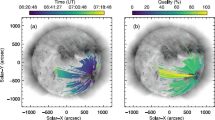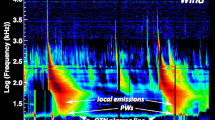Abstract
We statistically analyzed the kinematical evolution and wave pulse characteristics of 60 strong large-scale EUV wave events that occurred during January 2007 to February 2011 with the STEREO twin spacecraft. For the start velocity, the arithmetic mean is 312±115 km s−1 (within a range of 100 – 630 km s−1). For the mean (linear) velocity, the arithmetic mean is 254±76 km s−1 (within a range of 130 – 470 km s−1). 52 % of all waves under study show a distinct deceleration during their propagation (a≤−50 m s−2), the other 48 % are consistent with a constant speed within the uncertainties (−50≤a≤50 m s−2). The start velocity and the acceleration are strongly anticorrelated with c≈−0.8, i.e. initially faster events undergo stronger deceleration than slower events. The (smooth) transition between constant propagation for slow events and deceleration in faster events occurs at an EUV wave start-velocity of v≈230 km s−1, which corresponds well to the fast-mode speed in the quiet corona. These findings provide strong evidence that the EUV waves under study are indeed large-amplitude fast-mode MHD waves. This interpretation is also supported by the correlations obtained between the peak velocity and the peak amplitude, impulsiveness, and build-up time of the disturbance. We obtained the following association rates of EUV wave events with other solar phenomena: 95 % are associated with a coronal mass ejection (CME), 74 % to a solar flare, 15 % to interplanetary type II bursts, and 22 % to coronal type II bursts. These findings are consistent with the interpretation that the associated CMEs are the driving agents of the EUV waves.












Similar content being viewed by others
Notes
References
Attrill, G.D.R., Harra, L.K., van Driel-Gesztelyi, L., Démoulin, P.: 2007, Astrophys. J. Lett. 656, L101. DOI .
Bein, B.M., Berkebile-Stoiser, S., Veronig, A.M., Temmer, M., Muhr, N., Kienreich, I., Utz, D., Vršnak, B.: 2011, Astrophys. J. 738, 191. DOI .
Biesecker, D.A., Myers, D.C., Thompson, B.J., Hammer, D.M., Vourlidas, A.: 2002, Astrophys. J. 569, 1009. DOI .
Bougeret, J.L., Goetz, K., Kaiser, M.L., Bale, S.D., Kellogg, P.J., Maksimovic, M., et al.: 2008, Space Sci. Rev. 136, 487. DOI .
Chen, P.F., Wu, Y.: 2011, Astrophys. J. Lett. 732, L20. DOI .
Chen, P.F., Wu, S.T., Shibata, K., Fang, C.: 2002, Astrophys. J. Lett. 572, L99. DOI .
Cheng, X., Zhang, J., Olmedo, O., Vourlidas, A., Ding, M.D., Liu, Y.: 2012, Astrophys. J. Lett. 745, L5. DOI .
Cliver, E.W., Laurenza, M., Storini, M., Thompson, B.J.: 2005, Astrophys. J. 631, 604. DOI .
Cohen, O., Attrill, G.D.R., Manchester, W.B. IV, Wills-Davey, M.J.: 2009, Astrophys. J. 705, 587. DOI .
Dai, Y., Auchère, F., Vial, J., Tang, Y.H., Zong, W.G.: 2010, Astrophys. J. 708, 913. DOI .
Dai, Y., Ding, M.D., Chen, P.F., Zhang, J.: 2012, Astrophys. J. 759, 55. DOI .
Delaboudinière, J.-P., Artzner, G.E., Brunaud, J., Gabriel, A.H., Hochedez, J.F., Millier, F., et al.: 1995, Solar Phys. 162, 291. DOI .
Delannée, C.: 2000, Astrophys. J. 545, 512. DOI .
Delannée, C., Aulanier, G.: 1999, Solar Phys. 190, 107. DOI .
Delannée, C., Török, T., Aulanier, G., Hochedez, J.-F.: 2008, Solar Phys. 247, 123. DOI .
Domingo, V., Fleck, B., Poland, A.I.: 1995, Solar Phys. 162, 1. DOI .
Downs, C., Roussev, I.I., van der Holst, B., Lugaz, N., Sokolov, I.V., Gombosi, T.I.: 2011, Astrophys. J. 728, 2. DOI .
Efron, B.: 1979, Ann. Stat. 7, 1.
Gallagher, P.T., Long, D.M.: 2011, Space Sci. Rev. 158, 365. DOI .
Gopalswamy, N., Yashiro, S., Temmer, M., Davila, J., Thompson, W.T., Jones, S., McAteer, R.T.J., Wuelser, J.-P., Freeland, S., Howard, R.A.: 2009, Astrophys. J. Lett. 691, L123. DOI .
Harra, L.K., Sterling, A.C., Gömöry, P., Veronig, A.: 2011, Astrophys. J. Lett. 737, L4. DOI .
Hoilijoki, S., Pomoell, J., Vainio, R., Palmroth, M., Koskinen, H.E.J.: 2013, Solar Phys. 286, 493. DOI .
Howard, R.A., Moses, J.D., Vourlidas, A., Newmark, J.S., Socker, D.G., Plunkett, S.P., et al.: 2008, Space Sci. Rev. 136, 67. DOI .
Innes, D.E., Genetelli, A., Attie, R., Potts, H.E.: 2009, Astron. Astrophys. 495, 319. DOI .
Kaiser, M.L., Kucera, T.A., Davila, J.M., St. Cyr, O.C., Guhathakurta, M., Christian, E.: 2008, Space Sci. Rev. 136, 5. DOI .
Kienreich, I.W., Temmer, M., Veronig, A.M.: 2009, Astrophys. J. Lett. 703, L118. DOI .
Kienreich, I.W., Veronig, A.M., Muhr, N., Temmer, M., Vršnak, B., Nitta, N.: 2011, Astrophys. J. Lett. 727, L43. DOI .
Kienreich, I.W., Muhr, N., Veronig, A.M., Berghmans, D., De Groof, A., Temmer, M., Vršnak, B., Seaton, D.B.: 2013, Solar Phys. 286, 201. DOI .
Klassen, A., Aurass, H., Mann, G., Thompson, B.J.: 2000, Astron. Astrophys. Suppl. 141, 357. DOI .
Lemen, J.R., Title, A.M., Akin, D.J., Boerner, P.F., Chou, C., Drake, J.F., et al.: 2012, Solar Phys. 275, 17. DOI .
Li, T., Zhang, J., Yang, S., Liu, W.: 2012, Astrophys. J. 746, 13. DOI .
Liu, W., Ofman, L.: 2014, Solar Phys. 289, 3233. DOI .
Liu, W., Nitta, N.V., Schrijver, C.J., Title, A.M., Tarbell, T.D.: 2010, Astrophys. J. Lett. 723, L53. DOI .
Liu, W., Ofman, L., Nitta, N.V., Aschwanden, M.J., Schrijver, C.J., Title, A.M., Tarbell, T.D.: 2012, Astrophys. J. 753, 52. DOI .
Long, D.M., Gallagher, P.T., McAteer, R.T.J., Bloomfield, D.S.: 2008, Astrophys. J. Lett. 680, L81. DOI .
Long, D.M., Gallagher, P.T., McAteer, R.T.J., Bloomfield, D.S.: 2011, Astron. Astrophys. 531, A42. DOI .
Ma, S., Wills-Davey, M.J., Lin, J., Chen, P.F., Attrill, G.D.R., Chen, H., Zhao, S., Li, Q., Golub, L.: 2009, Astrophys. J. 707, 503. DOI .
Moses, D., Clette, F., Delaboudinière, J., Artzner, G.E., Bougnet, M., Brunaud, J., et al.: 1997, Solar Phys. 175, 571. DOI .
Muhr, N., Vršnak, B., Temmer, M., Veronig, A.M., Magdalenić, J.: 2010, Astrophys. J. 708, 1639. DOI .
Muhr, N., Veronig, A.M., Kienreich, I.W., Temmer, M., Vršnak, B.: 2011, Astrophys. J. 739, 89. DOI .
Nitta, N.V., Schrijver, C.J., Title, A.M., Liu, W.: 2013, Astrophys. J. 776, 58. DOI .
Nitta, N.V., Aschwanden, M.J., Freeland, S.L., Lemen, J.R., Wülser, J.-P., Zarro, D.M.: 2014, Solar Phys. 289, 1257. DOI .
Olmedo, O., Vourlidas, A., Zhang, J., Cheng, X.: 2012, Astrophys. J. 756, 143. DOI .
Patsourakos, S., Vourlidas, A.: 2009, Astrophys. J. Lett. 700, L182. DOI .
Patsourakos, S., Vourlidas, A.: 2012, Solar Phys. 281, 187. DOI .
Pesnell, W.D., Thompson, B.J., Chamberlin, P.C.: 2012, Solar Phys. 275, 3. DOI .
Podladchikova, O., Berghmans, D.: 2005, Solar Phys. 228, 265. DOI .
Podladchikova, O., Vourlidas, A., Van der Linden, R.A.M., Wülser, J., Patsourakos, S.: 2010, Astrophys. J. 709, 369. DOI .
Shen, Y., Liu, Y.: 2012, Astrophys. J. 754, 7. DOI .
Temmer, M., Veronig, A.M., Vršnak, B., Rybák, J., Gömöry, P., Stoiser, S., Maričić, D.: 2008, Astrophys. J. Lett. 673, L95. DOI .
Temmer, M., Veronig, A.M., Kontar, E.P., Krucker, S., Vršnak, B.: 2010, Astrophys. J. 712, 1410. DOI .
Temmer, M., Veronig, A.M., Gopalswamy, N., Yashiro, S.: 2011, Solar Phys. 273, 421. DOI .
Thompson, B.J., Myers, D.C.: 2009, Astrophys. J. Suppl. 183, 225. DOI .
Thompson, B.J., Plunkett, S.P., Gurman, J.B., Newmark, J.S., St. Cyr, O.C., Michels, D.J.: 1998, Geophys. Res. Lett. 25, 2465. DOI .
Thompson, B.J., Gurman, J.B., Neupert, W.M., Newmark, J.S., Delaboudinière, J.-P., St. Cyr, O.C., Stezelberger, S., Dere, K.P., Howard, R.A., Michels, D.J.: 1999, Astrophys. J. Lett. 517, L151. DOI .
Veronig, A.M., Temmer, M., Vršnak, B.: 2008, Astrophys. J. Lett. 681, L113. DOI .
Veronig, A.M., Muhr, N., Kienreich, I.W., Temmer, M., Vršnak, B.: 2010, Astrophys. J. Lett. 716, L57. DOI .
Veronig, A.M., Gömöry, P., Kienreich, I.W., Muhr, N., Vrsnak, B., Temmer, M., Warren, H.P.: 2011, Astrophys. J. Lett. 743, L10.
Vršnak, B., Cliver, E.W.: 2008, Solar Phys. 253, 215. DOI .
Vršnak, B., Lulić, S.: 2000, Solar Phys. 196, 157.
Vršnak, B., Warmuth, A., Brajša, R., Hanslmeier, A.: 2002, Astron. Astrophys. 394, 299. DOI .
Warmuth, A.: 2010, Adv. Space Res. 45, 527. DOI .
Warmuth, A., Mann, G.: 2011, Astron. Astrophys. 532, A151. DOI .
Warmuth, A., Vršnak, B., Magdalenić, J., Hanslmeier, A., Otruba, W.: 2004, Astron. Astrophys. 418, 1101. DOI .
Wills-Davey, M.J.: 2006, Astrophys. J. 645, 757. DOI .
Wills-Davey, M.J., Attrill, G.D.R.: 2010, Space Sci. Rev. 149, 325. DOI .
Wuelser, J., Lemen, J.R., Tarbell, T.D., Wolfson, C.J., Cannon, J.C., Carpenter, B.A., et al.: 2004, In: Fineschi, S., Gummin, M.A. (eds.) Telescopes and Instrumentation for Solar Astrophysics, Proc. SPIE 5171, 111. DOI .
Yang, L., Zhang, J., Liu, W., Li, T., Shen, Y.: 2013, Astrophys. J. 775, 39. DOI .
Zheng, R., Jiang, Y., Yang, J., Bi, Y., Hong, J., Yang, B., Yang, D.: 2012, Astrophys. J. 747, 67. DOI .
Zhukov, A.N., Auchère, F.: 2004, Astron. Astrophys. 427, 705. DOI .
Acknowledgements
N.M., I.W.K., A.M.V., and M.T. acknowledge the Austrian Science Fund (FWF): P20867-N16, P-24092-N16, and V195-N16. N.M. acknowledges the MOEL-Plus Förderprogramm. B.V. acknowledges financial support by Croatian Science Foundation under the project 6212 “Solar and Stellar Variability”. This work has received funding from the European Commission FP7 Project no. 284461 [eHEROES]. The STEREO/SECCHI data are produced by an international consortium of the Naval Research Laboratory (USA), Lockheed Martin Solar and Astrophysics Lab (USA), NASA Goddard Space Flight Center (USA), Rutherford Appleton Laboratory (UK), University of Birmingham (UK), Max-Planck-Institut für Sonnensystemforschung (Germany), Centre Spatiale de Liège (Belgium), Institut d’Optique Théorique et Appliquée (France), and Institut d’Astrophysique Spatiale (France).
Author information
Authors and Affiliations
Corresponding author
Appendix
Appendix
1.1 A.1 Comparison of the Visual Tracking and the Perturbation Profile Methods
Muhr et al. (2011) and Long et al. (2011) presented a comparison of the two basic methods that are used to derive EUV wave kinematics: visual tracking of the wave fronts, and perturbation profiles. The authors found a good consistency in the obtained results. However, both studies were using a small sample of four EUV wave events. Here we study a representative subsample of 12 events to which we applied the visual as well as the perturbation profile method on a series of BR images to compare the two kinematical analysis techniques. For both methods we focused on the same specific 45° sector in which the disturbances show highest contrast levels. In Figure 13 we display the correlation of the derived velocity values of the 12 EUV wave events. In the two panels the x-axes represent the velocities received by the visual tracking method, while the y-axes represent the velocities received by the perturbation profile method. Figure 13(a) shows the mean velocities and a linear fit to the data with a linear regression line of y=0.90x+21.8 and a correlation coefficient of 0.98±0.02. Figure 13(b) shows the start velocities at the first wave occurrences derived from the quadratic fits to the time-distance curves and a linear fit to the data with a linear regression line of y=1.12x−42.4, giving a correlation coefficient of 0.97±0.03. The high correlation coefficients and the linear fit parameters show that both methods give consistent results for the velocities that describe the EUV wave propagation.
Comparison of visual tracking and perturbation profile method. In the first panel the mean velocities of a representative subsample of 12 EUV waves derived from the visual tracking method (x-axis) are plotted against the mean velocity values derived from the perturbation profiles (y-axis). In the second panel the starting velocity values derived from both methods are plotted against each other. The solid lines are linear regression lines to the data points. The fit and the correlation coefficients are given in the inset. The dashed line is the one-to-one correspondence.
Rights and permissions
About this article
Cite this article
Muhr, N., Veronig, A.M., Kienreich, I.W. et al. Statistical Analysis of Large-Scale EUV Waves Observed by STEREO/EUVI. Sol Phys 289, 4563–4588 (2014). https://doi.org/10.1007/s11207-014-0594-7
Received:
Accepted:
Published:
Issue Date:
DOI: https://doi.org/10.1007/s11207-014-0594-7





